Abstract
The purpose of this study is to present the state of the art of recent research on nonverbal communication in L2 classroom interaction, in particular on teachers’ and students’ gestures, and then focus on a case of gestures in an L2 Italian classroom. A corpus of video-recorded interactions (CLODIS) were analyzed to answer the following research question: How do L2 Italian native teachers behave when addressing international students? Are there differences with what has been observed in other foreign language (L2) teaching contexts? Both previous data-based research on multimodality in L2 classes and the analysis on CLODIS show that teachers select and coordinate multiple semiotic modes as interactional resources to complete various teaching tasks. Furthermore, Italian native teachers use not only the typical pedagogical gestures (both iconic and metaphorical), but also culturally specific emblems that may cause misunderstandings or inappropriate mirroring effects. For these reasons, it is important that L2 teachers develop a good multimodal awareness, especially if they teach their mother tongue to foreign students and if they belong to a “contact culture”, as is the case observed in L2 Italian classes.
1. Introduction
Over the past few decades, the scientific community has been devoted to focusing more on classroom interaction, considering its various aspects from semiotic, sociolinguistic, pedagogical, and interactional perspectives. Of particular interest is research in the field of Conversation Analysis for Second Language Acquisition (CA-for-SLA) (Markee 2015), which also considers how nonverbal behavior interacts with verbal utterances in the negotiation between teaching and learning purposes (a recent overview in Stam and Tellier 2022).
Classroom interaction is a complex adaptive system, and this is particularly true in the case of foreign language teaching following a communicative approach. Teachers and learners are constantly engaged in a multimodal environment, in which gestures, eye gaze, silent pauses, laughter, body movements, positioning, distances, and other nonverbal codes replace speech or co-occur with it in a network of embodied actions.
Verbal and nonverbal resources are inextricably entwined in the foreign language classroom and may produce both mirroring effects, immediately visible in the asymmetric speech exchange with a teacher, and long-term effects, in a student’s mental process of language acquisition. From this perspective, teachers’ awareness of the role of verbal and nonverbal adaptation strategies, and making sure these are fine-tuned according to the students’ level of competence, is of crucial importance.
In this paper, I focus on gestures embodied as actions1 that foreign language teachers use when interacting with students in the target language. After a review of previous studies on teachers’ and students’ gestures in second language acquisition and classroom research2, I will discuss a case of recurring patterns observed in a corpus of video-recorded and transcribed lessons of Italian as a second language (L2), with adult students from different cultural and linguistic backgrounds. The case of Italian native speakers teaching their mother tongue to foreign students offers the possibility to discuss how deeply culture may influence their behavior, creating a strong tension between pragmatic and pedagogical needs in classroom face-to-face interaction. Moreover, the results of this data-driven analysis will be helpful in focusing on certain areas of classroom management that are more sensitive to nonverbal messages (teachers’ comprehensible oral input, vocabulary explanation, and oral corrective feedback; students’ oral feedback, repetition, and turn taking, etc.) and proving how the gesture–speech interface can serve as a mediation tool both for teachers and learners.
1.1. Teachers’ Gestures in the L2 Classroom: Literature Review
“The Teacher Moves” is the title of a pioneering book by Grant and Grant Hennings (1971) that opened a new perspective on teachers’ professional performance and included nonverbal behavior among the various aspects of professional expertise. As a matter of fact, face-to-face interaction is multimodal and involves how participants use their hands and position their body in ongoing talk, how they engage in mutual gaze to establish contact, or how they use facial displays to comment on what is being said or performed. Classroom interaction is an example of a complex network of communicative codes with shared teaching/learning purposes (Hall and Looney 2019).
The growing body of analytic research on ethnomethodological conversation in teaching has revealed the huge variety of actions that teachers (also L2 teachers) put in practice to manage different teaching tasks. Especially with the availability of video-recorded interactions for qualitative and quantitative analysis, scholars have been able to demonstrate how teachers employ both verbal and other embodied interactional resources (nonverbal sounds, prosody, silence, laughter, body movements) in a complex “multimodal Gestalt” (Mondada 2014) to achieve instructional goals and respond to students’ needs. Multimodality refers to all these interactional means that occur either simultaneously or separately and without a specific hierarchy. Within multimodality, embodied actions focus in particular on the body and how it plays its part in interaction (body posture, head movements, facial expressions, smile, gestures and gaze shifts) (Poggi 2006). The analysis of a collection of video-recorded lessons enables us to examine all these semiotic resources as a whole, without separating verbal messages, nonverbal sounds, paralanguage and body movements, which are all observed in teacher–student interactions (Walsh 2006, 2013, 2014; Hall and Smotrova 2013; Sert 2015).
In recent years, L2 teachers’ gestures have been put under the lens by scholars to identify the recurring patterns in various contexts and with different languages3, sharing the specificity of this institutional and asymmetric interactional setting.
The classical gesture taxonomies4 are a reference point, but the gestures that emerge in the L2 classroom need more specific description tools. An attempt was made by David McNeill’s classification system of hand movements (McNeill 1992), which distinguishes deictics (indicating physical referents present in the setting), iconics (depicting physical shapes), metaphorics (representing abstract concepts), cohesives (used to connect narrative elements), and beats (which provide emphasis and tempo). In addition to these, another category of gestures can be considered, taken from the previous and more detailed taxonomy of gestures offered by Ekman and Friesen (1969, pp. 62–92): the so-called “emblems”. These gestures—mostly hand and head movements—are culturally specific and conventionally transmitted; they are performed with a certain degree of consciousness, they arise with or without speech, and are often difficult to interpret, as they have no or little relationship with their meaning.
Considering the importance of language in the L2 classroom, it is relevant to reflect on how gestures interact with speech. From this point of view, the first category of gestures that teachers use are the so-called “co-speech gestures” (McNeill 1992, 2005). They are unconscious and occur simultaneously with speech, with the same representational, deictic, or interactive function expressed with words. A second category are the “speech-linked gestures” (Stam 2018), which mostly happen unconsciously and simultaneously with speech but can also precede or follow the verbal utterances or fill the silent pauses.
From the point of view of their different functions, Stam and Tellier (2022) offer a taxonomy of L2 that distinguishes the following:
- (a)
- Gestures to inform about language: these may refer to grammar, vocabulary, and phonology. Teachers may use them to explain morphosyntax and temporality (Matsumoto and Mueller Dobs 2016; Bianchi and Diadori 2018) or to focus on the forms and meanings of action verbs (Tellier and Stam 2012) and lexical items (Lazaraton 2004; Smotrova and Lantolf 2013; García-Gámez and Macizo 2023). They can also help in the physical production of phonemes and prosody (Smotrova 2017). Such gestures occur to solve misunderstandings, to anticipate students’ difficulties, to facilitate oral comprehension5, and to help students’ performance.
- (b)
- Gestures as assessment tools: they are used to approve students’ performance or, as corrective feedback, to report an error without verbally interrupting a student’s production (Mackey et al. 2000; Seo and Koshik 2010)
- (c)
- Gestures to manage the class: they are often used to indicate the beginning and the end of an activity and to decide speech turns (Mondada 2007). Gestures and eye gaze may be used by teachers in organizing students when giving instructions (Arnold 2012; Käänta 2012; Hall and Smotrova 2013; Azaoui 2014). Teachers may fill a period of silence with gestures with different communicative functions, e.g., to elicit an answer from the class, to help the interlocutor in verbal oral production, or to fill in an incomplete sentence (Stam and Tellier 2017).
In one-on-one interaction, pedagogical gestures are also helpful in managing the proximal development zone, i.e., “the distance between the actual developmental level as determined by independent problem solving and the level of potential development as determined through problem solving under adult guidance or in collaboration with more capable peers” (Vygotsky 1978, p. 86). McCafferty (2002) explored this role in a longitudinal study on video-recorded interactions between a native and a non-native speaker of ESL, demonstrating how gestures helped to create a sense of shared social, symbolic, physical, and mental space.
Similar to verbal adaptation, L2 teacher talk shows that pedagogical embodied actions are adapted according to the students’ competencies. When new information is presented, the gestures that accompany it are usually more pronounced than when the same information is repeated for the same audience (Galati and Brennan 2013). Moreover, similar accommodation strategies can be observed when addressing students with lower or higher language competence in L2: with beginners, teachers simplify their vocabulary, slow down their speech rate, use a higher voice volume, repeat keywords, reformulate sentences and questions, and increase the degree of iconicity of their gestures, which are more pronounced and more informative (Allen 2000). Taking into consideration the interactions a native vs. non-native speaker may have, it has also been demonstrated that different gesture adjustments takes place: when addressing the non-native speaker, there is a change in quantity (more gestures), time (longer duration), size (more pronounced gestures), and type (more illustrative gestures) (Tellier et al. 2021).
Such adaptation increases when misunderstandings occur, and takes place especially during speech pauses, after or before a relevant speech act, in order to facilitate oral comprehension (Kelly et al. 1999; Sueyoshi and Hardison 2005; Kang et al. 2013; Stam and Tellier 2017). Also, iconic gestures are the types that most positively influence comprehension (Kang et al. 2013). Through empirical tests, it has been demonstrated that when an oral presentation of the teacher was accompanied by relevant images (e.g., a cartoon) both oral comprehension and later recall improved compared to the same oral input based only on speech (Dahl and Ludvigsen 2014).
1.2. Students’ Gestures in the L2 Classroom: Literature Review
Scholars have also observed interactions between teachers and students, focusing on students’ embodied actions like gestures, which are influenced by their cultural identity, by the previous interaction experiences they have gathered, and by an immediate teacher’ s nonverbal behavior6. Students may use gestures both consciously (to replace words that are not accessible) and unconsciously (to reflect one’s way of thinking or to mirror the teachers’ actions).
It is important to consider that each native language implies a specific way of “thinking for speaking”, which is also reflected in embodied actions. When learning a new language, especially if this is typologically distant from one’s L1, students need to learn new patterns. In certain cases, the timing of their gestures indicates that they are speaking in L2 but they are thinking according to their L1 system, or somewhere between L1 and L2, as is typically observed in their interlanguage7, referring to its verbal components. As a matter of fact, an L2 interlanguage is a combination of language and embodied actions, both gradually approaching the L2 multimodal communicative system by means of positive and negative interference phenomena, hypergeneralizations, personal hypothesis, etc. (Stam 2008). A teacher’s task is to guide the student to progressively adapt their verbal and nonverbal behavior and inner thought to the target language and culture.
Students’ gestures play a relevant role in their learning processes. They reveal mental phenomena such as attention, memory, problem solving, and reasoning. As visible representation of their cognitive activity when using the L2, they may help the teacher to understand their needs and acquired skills8. They can also be analyzed as a manifestation of their representation of L2 identity and nonverbal behavior, integrating nonverbal habits of the target language (or believed as such) into their interlanguage.
Frequently, L2 students have gaps in their vocabulary and use iconic gestures to simulate a real object, metaphorical gestures for abstract concepts, or deictics to point out what is present in the setting where an interaction takes place. Such embodied lexical retrieval may refer to different cognitive processes when the student is searching for a word that is known but difficult to retrieve, or when the word is definitely missing (Stam 2012).
Students’ embodied actions have been studied according to the communicative task requested in L2. When engaged in a presentation task, they use more metaphoric gestures, while iconic gestures are more frequent when they are answering a teacher’s questions (Tabensky 2008; Stam 2016). In general, representational gestures have been proven to help oral production, both in L2 and in L1, and to increase classroom interactional competence in L2 students (Kita 2000; Graziano and Gullberg 2013; Park 2017).
Other research has focused on student performance and perception in relation to teachers’ embodied actions (Sime 2006, 2008). Pedagogical gestures have often shown a positive impact on L2 listening comprehension9, but they can also cause misunderstandings when they are too symbolic or culturally specific.10 As an example, the same symbolic hand gesture that means “ok” in Italy is very rude in Japan. Again, it is important that teachers are aware of the potential of gestures as teaching aids, but also of the risks they may imply (Sime 2006).
On the other hand, students’ gestures may have an impact on teachers’ evaluation of their competence in the L2. Various research has demonstrated that their oral proficiency gives better results when their video-recorded production is assessed by taking their nonverbal behavior into account as well, compared to the same audio-recorded performance where the evaluation is based only on the voice (Gullberg 1998). A higher score is also awarded to those students whose gestuality is more like that typical of L2 native speakers (Neu 1990; Jenkins and Parra 2003). This implies the importance of considering who produces, receives, and interprets gestures.11
A very interesting area of investigation refers to the action of pedagogical gestures in scaffolding and reinforcing the L2 learning process by affecting long-term memorization, and it has been highlighted by various longitudinal studies on different languages and with different student ages (Allen 1995; Tellier 2008b; Macedonia and Klimesch 2014). From a psychological point of view, it has been demonstrated that gestures that indicate real objects or actions are stored together with the corresponding words in the same area of the brain; therefore, the act of observing gestures could potentially strengthen the connections between new vocabulary and the semantic system, much like actually performing the gestures involved. As a consequence, iconic gestures used by the teacher as a scaffolding technique for L2 teaching purposes (as well as images) have an important role in students’ lexical retrieval (Krauss and Morsella 2001; García-Gámez and Macizo 2023), as they act directly on the cognitive processes of learners, fostering both memorization and logical reasoning (Alibali et al. 2001; Cooperrider and Goldin-Meadow 2017). To summarize, according to Abner et al. (2015, p. 444), the use of gestures can help students in the following ways: (1) in finding words; (2) in thinking in terms of space; (3) in making complex concepts explicit; and (4) in facilitating the retrieval of information in the working memory.
1.3. Shared Gestures in the L2 Classroom: Literature Review
Gestures shared by teachers and students have been studied in the L2 classroom as resources in facilitating mutual interaction (Eskildsen and Wagner 2013) because nonverbal communication in certain circumstances is a necessary tool from both sides, though it is not immune from mistakes and misunderstandings (Seymen 2014). Both teachers and students, e.g., use embodied actions, especially gestures, to make abstract concepts visible (Majlesi and Markee 2018; Matsumoto and Mueller Dobs 2016).
An interesting phenomenon is nonverbal mirroring in the classroom. Teachers may consciously imitate students’ embodied actions (gestures, laugh, eye gaze)—especially in one-to-one instructional settings—to create a positive rapport that is also relevant for language learning (Zhou and Guo 2012). According to Tickle-Degnen and Rosenthal (1990), such rapport is revealed by mutual attentiveness, positivity (when participants feel the friendliness and warmth of others and show mutual respect and care), and interpersonal coordination (when participants predict and respond spontaneously and synchronically to each other).
On the other hand, L2 students generally tend to imitate not only a teacher’s verbal input in the target language, but also his/her embodied actions thanks to the innate presence of mirror neurons in the human brain. While verbal mirroring is conscious and often accompanied by a cognitive effort (e.g., in reproducing sounds or memorizing words and language sequences), nonverbal mirroring is mostly sub-conscious, but has a relevant role in language learning as well. Mirroring a model speaker’s beat gesture produced by the teacher simultaneously with speech enhances perceptual and production prominence and helps the learner to reproduce the prosody and rhythm of the target language (Yamane et al. 2019).
1.4. The Case of Teachers’ Gestures in the L2 Italian Classroom
The case of teachers’ gestures in the L2 Italian classroom is worth special attention, due to the role that body movements have in the Italian culture12. As part of the so called “contact cultures”, living in the areas facing the Mediterranean Sea, Italian native speakers employ a relevant number of embodied actions in interaction compared to people living in Northern Europe, in Northern America, or in the far East. A higher tone of voice, eye contact, close distances between speakers, and a large variety of gestures, including many emblems, make the Italian way of talking a unique combination of speech and body movements that create a strong proximity among interlocutors, even in formal situations. This is often mistaken by foreigners for impolite or intrusive behavior, while it is simply a culturally specific pragmatic communicative mode, especially typical of southern Italians (Kendon 1995).
How do L2 Italian native teachers behave in the classroom when addressing international students in order to teach them the Italian language and culture? Are there differences with what has been observed in other L2 teaching contexts?
One difference is certainly the introduction of an explicit presentation of Italian symbolic gestures as part of the teaching program, which is associated with their meaning and the verbal expressions they may accompany or replace. International students are often impressed or even embarrassed by them, and a mediation is necessary to interpret their meaning and register in order to avoid misunderstandings. For this reason, in the L2 Italian classroom special attention is devoted to gestures as a means of communication, using images, videos, and even the embodied corresponding movements of the teacher.
On the other hand, L2 Italian native teachers adopt a much more gesture-rich communicative mode compared to other L2 teachers, as described in the abovementioned literature.
2. Materials and Methods
A number of examples have been selected from a corpus of L2 Italian lessons called CLODIS13 to explore the specificity of gestures used in real institutional settings when the target language of instruction is Italian14. This corpus contains 212 interactions of around five minutes each, video-recorded in classes of L2 Italian, and collected between 2003 and 2020. The lessons take place both in Italy and abroad, with children, teenagers, and adults, and native and non-native teachers. Each video is focused on a teaching act (explanation, instruction, elicitation of conversation, error correction, etc.) and each interaction between a teacher and students has been transcribed using Gail Jefferson’s notation system (Jefferson 1984, 2004), integrated with some symbols specific for classroom interaction, among which the possibility to also specify which nonverbal behavior is associated with speech is available (see Appendix A). CLODIS is currently used to train prospective Italian L2 teachers in courses aimed at developing classroom interactional competence and for research purposes within the field of Conversation Analysis for Second Language Acquisition.
3. Results
The following considerations, which also take into account the literature on L2 Italian classroom interaction (see note 12), are based on a few representative cases taken from CLODIS to illustrate some specific gestures used by Italian native teachers in classes of international adult students with a variety of cultural and linguistic backgrounds, and also a variety of motivations in institutional settings like universities, private schools, and associations, both in Italy and abroad. The few cases that will be discussed as examples of the cultural background of L2 native teachers are iconic and metaphorical gestures, two categories of pedagogical gestures that, together with beats and deictics, are a constant feature of L2 Italian native teachers, and as such are also frequently observable in CLODIS. Some considerations of students’ mirroring gestures will conclude this section.
3.1. Iconic Gestures
As has often been pointed out, gestures are particularly useful as a visuospatial information channel to represent space, shapes, and actions that cannot be conveyed only using speech, or that become more comprehensible by a combination of verbal and visual input, which is the case in teaching an L215. As expected, many of these iconic gestures have been found in CLODIS. Some of them have been compared with the corresponding meaning of lexis referred to in the Italian Sign Language Dictionary (Lingua Italiana dei Segni—LIS), with surprising results16. Examples 1–3 show a teacher accompanying her speech with three hand movements that are the exact representation of the corresponding LIS signs. In the first example, she is using the word “panche” (“benches”) while indicating with the position of her hands the flat shape of this object (Figure 1) (same gesture in the LIS sign for “bench”, Figure 2). In the second one, she is explaining the meaning of the adjective “pigro” (“lazy”) by means of its contrary, “dinamico” (“dynamic”) accompanied by the movement of both fists (Figure 3), like in the LIS sign for “dynamic” (Figure 4). In the third one, she is talking about the tent that prevents the sun from entering the room, quoting the verb “entrare” (“to enter”), while her right hand mimes this movement (Figure 5), like the LIS sign for the verb “to enter” (Figure 6). Such exact correspondence indicates the double channel (visual and verbal) that is intentionally used by the teacher to make her words more comprehensible to foreign students who do not necessarily understand the oral input.
- EXAMPLE 1
| DF in campagna ((CNV indica con le mani la forma di un oggetto piatto) ci sono le panche) per sedere |
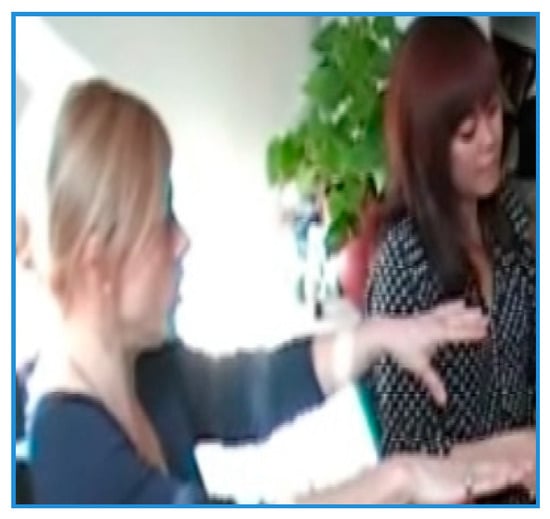
Figure 1.
Teacher referring to “benches”.
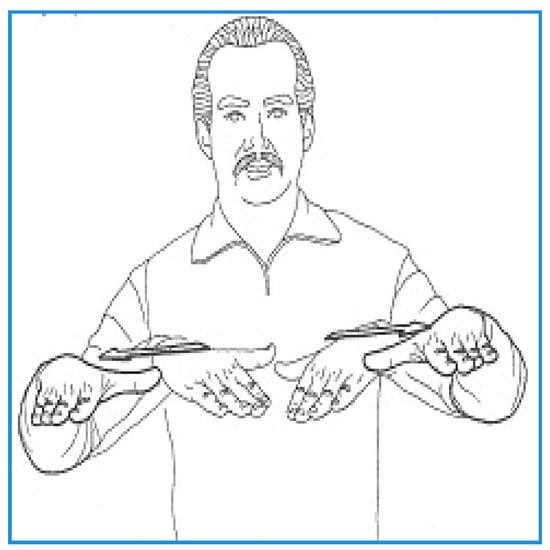
Figure 2.
LIS sign for “panca” (“bench”).
- EXAMPLE 2
| DF CHE VUOL DIRE PIGRA, (.) qualcuno sa cosa significa pigra, SF quando una persona non (1.0) vuole fare niente DF ((CNV annuisce)) È IL CONTRARIO DI PIGRO È ATTIVO DINAMICO) |
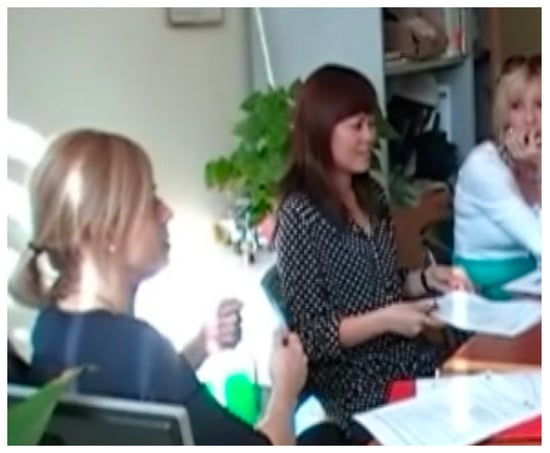
Figure 3.
Teacher referring to a “dynamic” person.
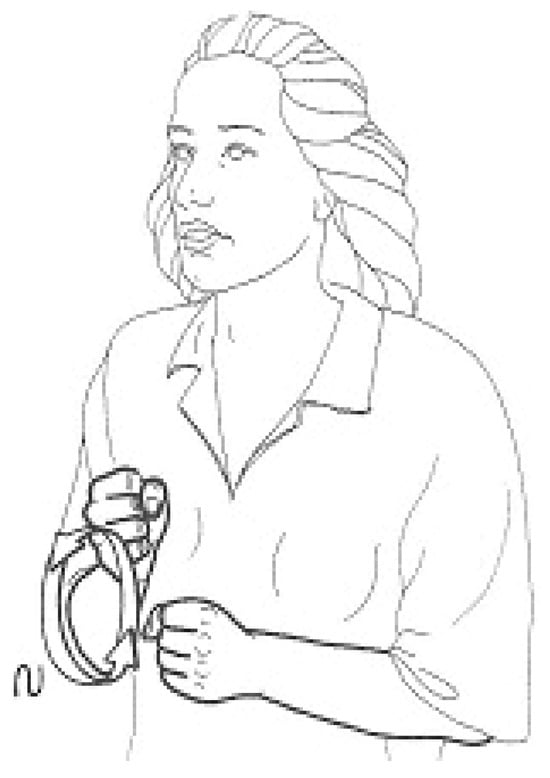
Figure 4.
LIS sign for “dinamico” (“dynamic”).
- EXAMPLE 3
| DF qui c’è la tenda perché così ((CNV movimento delle mani mima l’atto di entrare) non entra) il sole nella stanza |
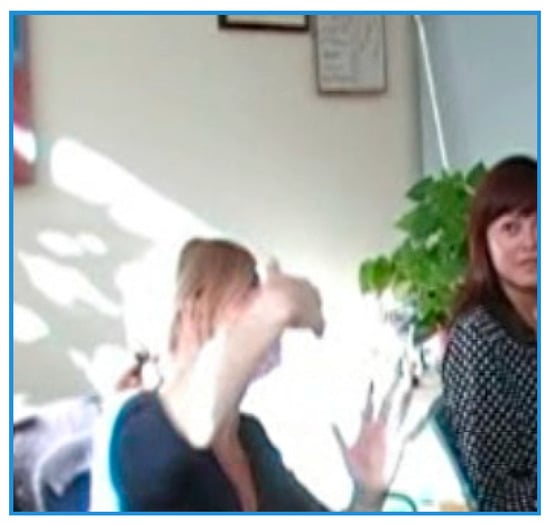
Figure 5.
Teacher referring to the sun “entering” the room.
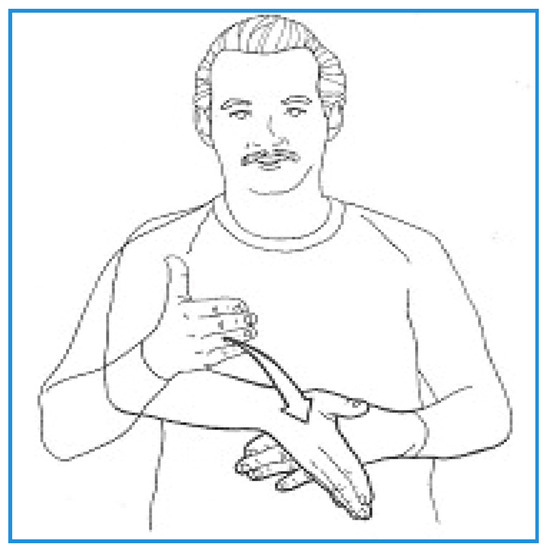
Figure 6.
LIS sing for “entrare” (“to enter”).
A fourth example was also taken from a lesson for international academic students. Here, the teacher is promoting a discussion on how people in Italy often do not follow the queue in shops or at the bus station. A Japanese student has just intervened with his experience, during which he had politely expressed his disappointment in a person who skipped the queue. Another student was making a negative nod, therefore the teacher asks him if, in the same situation, he would be more aggressive (“tu saresti più aggressivo”), by using his hands (“con le mani”). While saying so she grabs her left arm to show what being aggressive means (Figure 7).
- EXAMPLE 4
| DF Tu saresti più aggressivo? fisicamente ((CNV fa segno di stringere un braccio e tirare con le mani) cioè con le mani) SM La lingua è ferma e le mani lavorano ((CNV ride). |
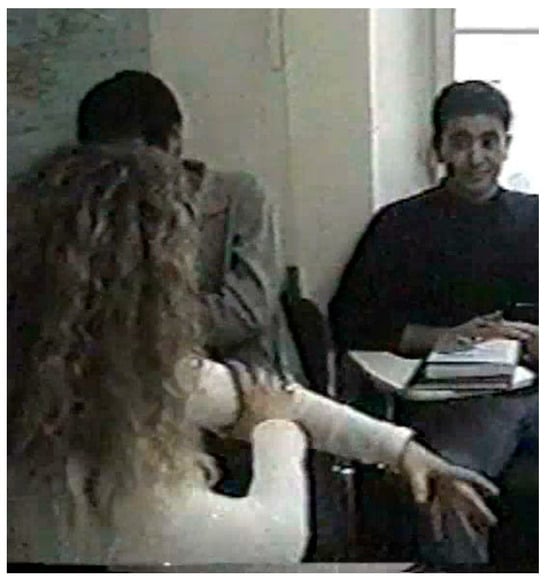
Figure 7.
Teacher referring to an aggressive behavior.
3.2. Metaphoric Gestures
A fifth example refers to a rather gesticulative teacher, who continuously moves back and forth towards the students while explaining a particular use of the subjunctive tense to express a doubt in Italian (“congiuntivo dubitativo”). When she reminds the students that they had worked around the idea of expressing a doubt (“abbiamo lavorato intorno all’idea di esprimere un dubbio”), she opens her arms to create a round circle while using the words “intorno all’idea” (“around the idea”) (Figure 8). In this case, the gesture does not represent a real object, shape or action, but tries to identify an abstract concept in spatial terms by means of the visible metaphor of a circle.
- EXAMPLE 5
| DF qual è il congiuntivo del verbo stare, CLA stia DF che stia dormendo, (1.0) ((CNV allarga le braccia) chiaro ragazzi,) (.)quindi noi abbiamo lavorato ((CNV con le braccia disegna un cerchio immaginario) intorno all’idea) di esprimere un dubbio (.) adesso formiamo un aggettivo dalla parola dubbio, (.) |
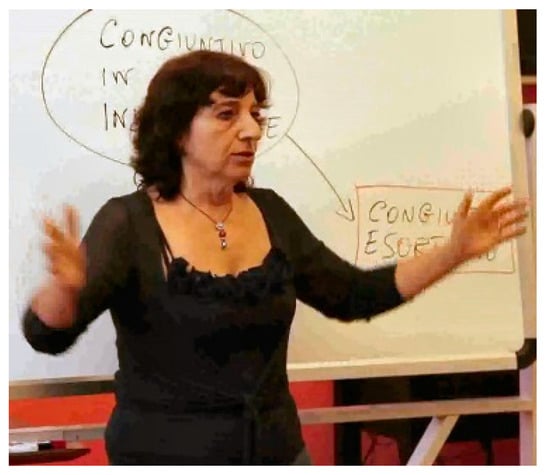
Figure 8.
Teacher referring to the work done “around” the idea of expressing a doubt.
Metaphoric gestures often refer to time. CLODIS transcriptions have been interrogated by searching the keywords “NVC” (nonverbal communication) and “time” to identify recurring patterns (Bianchi and Diadori 2018). As a result, it was found that all the categories considered (present, past, and future) were referred to by means of co-speech metaphorical gestures, both when the grammatical explanation was involved (as pedagogical gestures) and when it was not (referential gestures). This means that teachers, as native speakers of Italian, in both cases used the conventional embodied actions of time that characterize contemporary Italian culture. Each time they use the sagittal axis that identifies the past behind the speaker’s shoulders and future in front of him/her, while the present moment is indicated by pointing to one’s feet. The representation of time on a front/back is typical of the Italian culture17, but this is not a universal metaphor for identifying time referring to space. Concepts like “before”, “later”, “long ago”, “now” “in the future” are embodied in different ways in different cultures. In the Chinese culture, a gesture pointing up indicates the past and one pointing down indicates the future. Other cultures, for instance Jewish people, use a transversal axis from right to left, probably influenced by their handwriting. Finally, other people identify the past in front of them because it is known and the future behind as it is not to be seen (Núñez and Cooperrider 2013).
The pedagogical purpose of time gestures in CLODIS is demonstrated by the fact that they are mostly accompanied by a verbal expression of time (60%), especially when they are referring to the past (75%). In these cases, we can suppose that teachers use them as metaphorical representations of co-occurrent speech in order to make their words more comprehensible and to influence memorization by the combination of language and co-occurring visual input.
Considering the difficulty of the Italian language when referring to the past due to its complex verbal system, it is not surprising that the most represented category of time gestures in CLODIS is related to the past time.
When speaking of a recent past, teachers use the same LIS gesture (Figure 9), indicating “yesterday”, as in Example 6, where the teacher points backwards while saying “cinque minuti fa” (“five minutes ago”) (Figure 10).
- EXAMPLE 6
| DF quando vogliamo raccontare↑ (.) un’esperienza (.) passata. (.) d’accordo? (.) una cosa↑ (.) che è (.) del nostro passato (.) recente (.) ((CNV il pollice indietro indica un’azione passata) cinque minuti fa) (.) o anche molto lontano (.) venti anni fa. (.) d’accordo? (.) bene (.) dobbiamo usare questi due↑ (.) eh: mhm tempi verbali↑ |
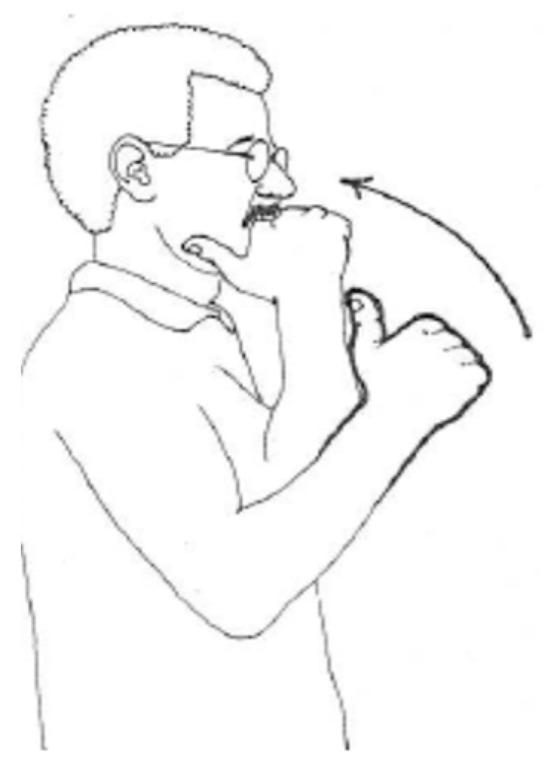
Figure 9.
LIS sign for “passato” (“past”).
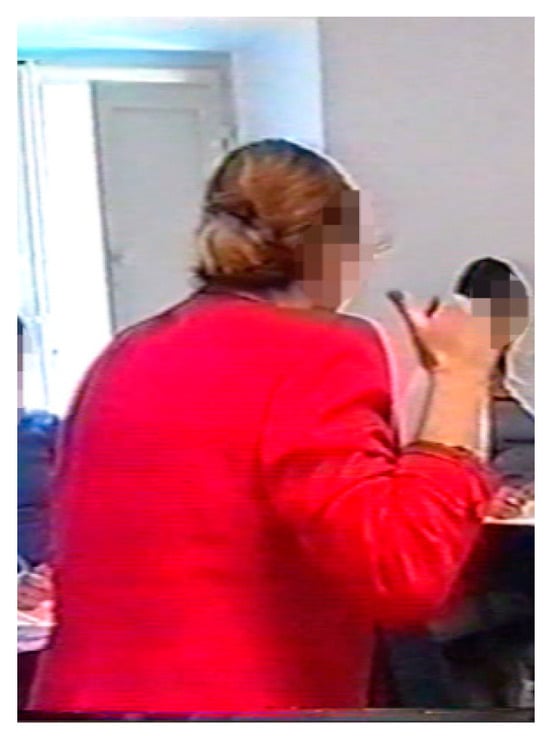
Figure 10.
Teacher referring to “five minutes ago”.
In other cases, the time gesture that refers to the past indicates a specific period of time, like in Example 7, where the teacher accompanies the expression “quando ero piccola” (“when I was young”) with the hand movement indicating the height of a little girl (Figure 11), the same gesture that corresponds to the word “child” in the LIS language (Figure 12).
- EXAMPLE 7
| DF (.) allora (.) ((CNV la mano indica l’altezza di un bambino) quando ero bambina quando ero piccola) (1.0) e a questo punto (.) anche se (.) il fatto (.) è di molto (.) tempo fa: (.) eh, (.) è successo (.) alcuni anni fa ((ridendo) insomma tu sei giovane ma (.) quando eri piccola) sono già passati qualcosa come vent’anni (.) ma BENE (.) in questo caso tu:: usi (.) preferibilmente (.) il passato prossimo |
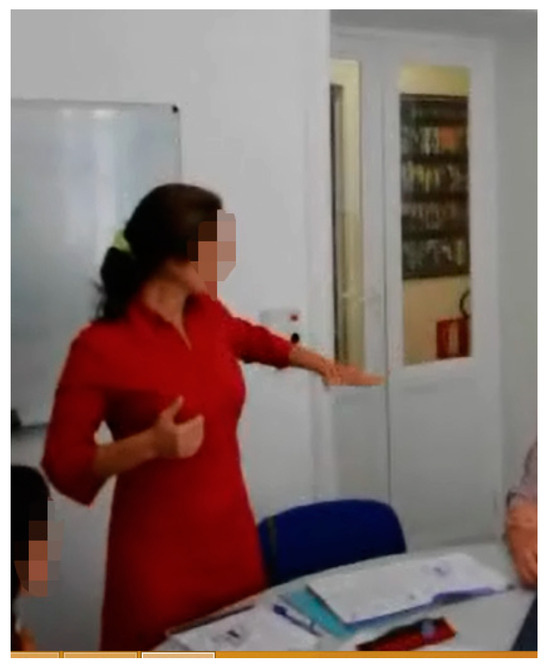
Figure 11.
Teacher referring to herself as a “child”.
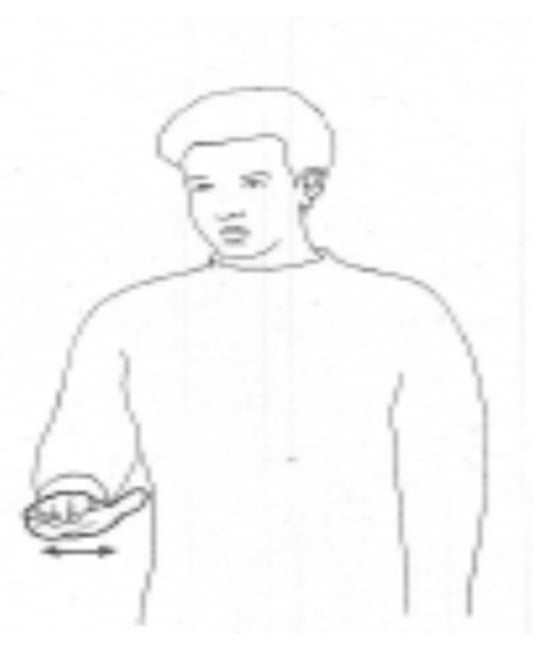
Figure 12.
LIS gesture for “bambino” (“child”).
A limited number of gestures in CLODIS are used by teachers to express the future. In Example 8, the teacher accompanies the words “e poi?” (“what else?”) to a rotatory movement of the right hand directed forward (Figure 13), which corresponds to the LIS sign for “the day after tomorrow” (Figure 14).
- EXAMPLE 8
| SM (1.0) faccio una gas- de- gos- degustia- (.) degustazione (.) mangio il formaggio (.) con il miele e la marmellata di uva ((leggendo alla lavagna)) ANCH’IO CLA ((CNV risate)) DM anch’io? ((CNV movimento rotatorio della mano destra in avanti) e poi?) (3.0) che altro che altro (1.0) “what else” che altro altro |
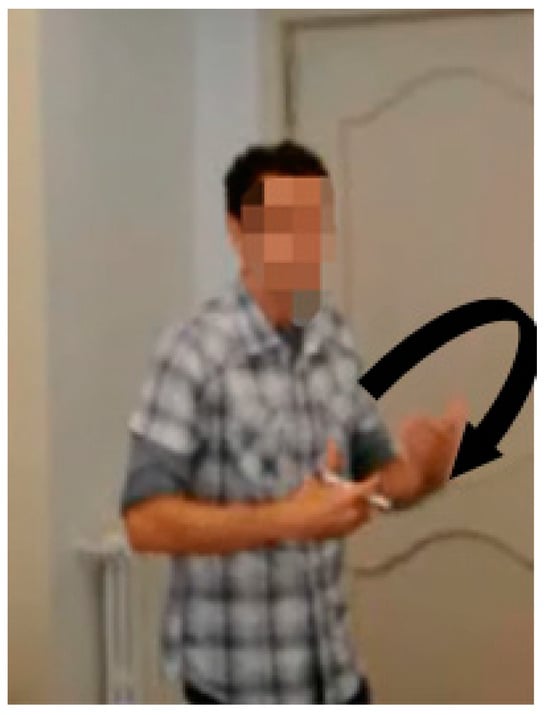
Figure 13.
Teacher inviting to give more examples: “what else?”.
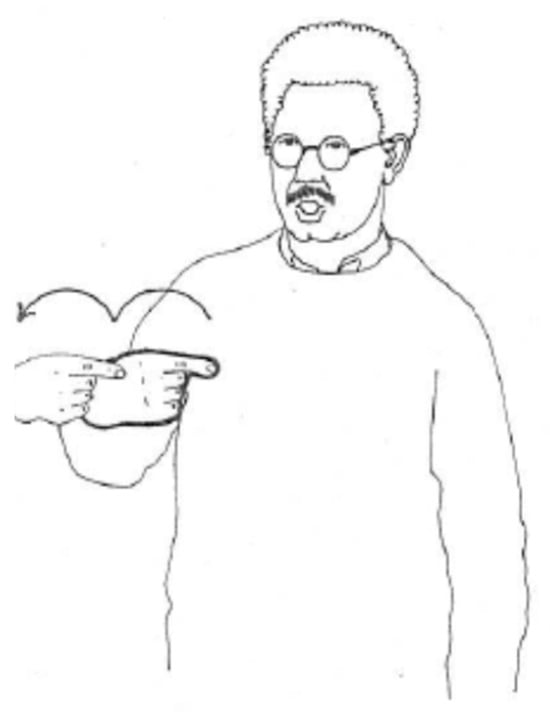
Figure 14.
LIS gesture for “e poi?” (“what else?”).
A temporal localization referring to the future is represented in Example 9, where the teacher looks at the watch on her wrist while saying “fra cinque minuti” (“in five minutes”) (Figure 15).
- EXAMPLE 9
| DF è un periodo ipotetico della possibilità (.) cioè tutto può cambiare (.) magari (1.0) ((CNV guarda l’orologio) tra cinque minuti) viene fuori il sole e usciamo (.) eh, (.) però (.) |
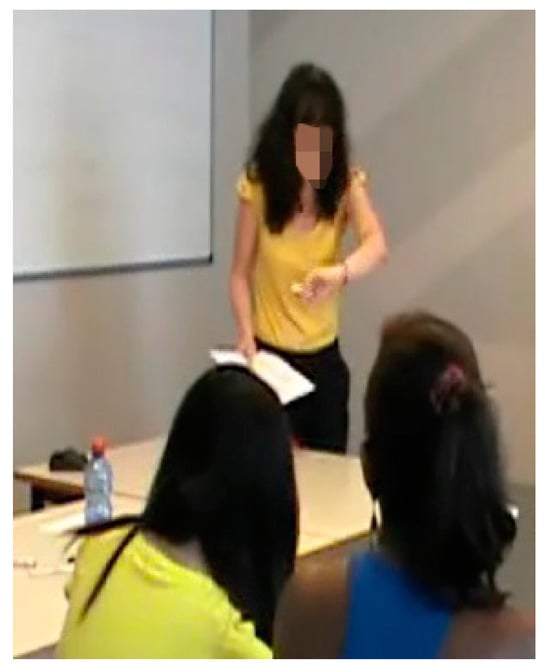
Figure 15.
Teacher referring to what will happen “in five minutes”.
Another case of exact correspondence between a time gesture in teacher talk and in LIS language is the typical one referring to the present: in Example 10, the teacher accompanies the index finger pointing to his feet with the word “oggi” (“today”) (Figure 16), the same gesture that in LIS means “today, now” (Figure 17).
- EXAMPLE 10
| DM nell’attività che vorrei fare ((CNV l’indice della mano destra indica in basso) oggi) con voi (1.0) vorrei anche (.) fare una specie di mercato |
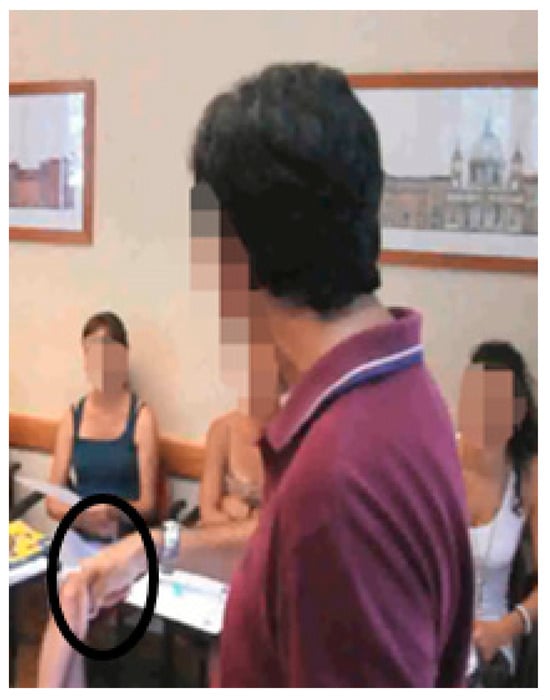
Figure 16.
Teacher referring to the present time (“today”).
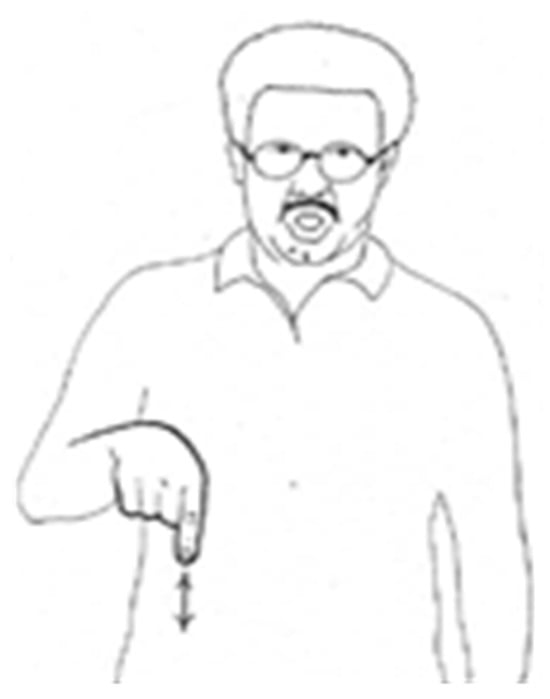
Figure 17.
LIS sign for “oggi” (“today, now”).
3.3. Metaphoric Gestures: The Case of Italian Emblems
Expert L2 native Italian teachers, although particularly gesticulative, tend to adapt their pedagogical gestures to students’ needs as any other L2 teacher, as seen with the previous examples of iconic and metaphorical gestures, in order to make their speech more comprehensible. But, in certain cases, their cultural identity emerges spontaneously, like when they use Italian symbolic gestures (emblems) without any pedagogical purpose, simply as a natural pragmatic expressive mode. The occurrence of such signals of cultural identity has been pointed out as a possible cause of misunderstandings in EFL contexts (Hauge 1998) and as an identity feature in IFL contexts (Peltier and McCafferty 2010). Although the rich Italian contemporary repertoire of emblems may easily produce such a consequence, no evident misunderstandings due to them used by teachers have been detected in CLODIS18. On the other hand, it is confirmed that they are occasionally and sub-consciously used to reinforce speech when the message prevails on the pedagogical function of their talk.
To what extent does the culturally specific use of Italian symbolic gestures interact with other types of gestures in the case of an Italian native teacher? Example 10 shows that they occasionally occur among other iconic and metaphorical gestures without any explanation when the teacher is particularly focused on meaning, and probably without even being noticed by the students. Here, the teacher is explaining to a class of beginners in L2 Italian the difficult rule of the imperfect tense compared to the past tense (“passato prossimo”) that corresponds to a past action that has a beginning and an end, no matter how long ago it happened or how long it lasted.
- EXAMPLE 1119
| DF ho camminato) (.) ho mangiato (.) ho studiato (.) queste sono (.) azioni (.) che (.) ((CNV indica con la mano un punto di inizio) iniziano) (.) ((CNV scuote la mano in senso orizzontale a indicare la fine di qualcosa) e finiscono) (.) ieri (.) ho studiato (.) ((CNV con la mano indica il numero tre) tre ore) (2.0) ((CNV indica la frase alla lavagna) sono stata in Francia) (.) per ((CNV indica con il pollice il numero uno) un mese) (2.0) non è importante (.) ((CNV con le braccia larghe disegna un segmento in aria) quanto tempo è lunga quanto è lunga quest’azione) (.) non è importante ((CNV fa il gesto della mano sotto il mento) chi se ne frega) ((CNV cerchia una parola alla lavagna)) (3.0) ((CNV con l’indice alzato segnala il numero uno) un mese un’ora un minuto un giorno) (.) non importa (.) che cosa, è importante. SM1 °l’azione° SM2 ((CNV annuisce) è importante l’azione,) |
The transcription referred to in Example 11 presents 10 co-speech gestures, each indicated by the acronym CNV = Comunicazione Non Verbale (nonverbal communication):
- ((CNV indica con la mano un punto di inizio) iniziano);
- ((CNV scuote la mano in senso orizzontale a indicare la fine di qualcosa) e finiscono);
- ((CNV con la mano indica il numero tre) tre ore);
- ((CNV indica la frase alla lavagna) sono stata in Francia);
- ((CNV indica con il pollice il numero uno) un mese);
- non è importante ((CNV con le braccia larghe disegna un segmento in aria) quanto tempo è lunga quanto è lunga quest’azione);
- non è importante ((CNV fa il gesto della mano sotto il mento) chi se ne frega);
- ((CNV cerchia una parola alla lavagna));
- ((CNV con l’indice alzato segnala il numero uno) un mese un’ora un minuto un giorno);
- ((CNV annuisce) è importante l’azione).
Gestures n.1, n.2, and n.6 are metaphorical and express the beginning and the end of an action, indicating an imaginary segment in space; n.3, n.5, and n.9 are iconics that associate the numeric expressions to the corresponding fingers used in Italy (thumb for number one; thumb, index, and middle finger for number three); n.4 and n.8 are deictic gestures pointing to the blackboard, where examples referring to the past tense are visible. Finally, n.7 and n.10 are symbolic gestures, and their meaning is culturally specific: n.7 (represented in Figure 18) is the so called “chin flick gesture” (Figure 19), expressing in Italy “I don’t care”; all fingers of the right hand are flattened with the palm facing one’s body, and then they are flicked out from under one’s chin with indifference; n.10 is a nod, made by moving the head up–down along a sagittal axis to express approval (“yes, you are right”). Not all cultures use the same gesture for an affirmative answer (“yes”), and not all cultures use the chin flick gesture a synonym of “I do not care”. This is one of the 20 emblems collected in Morris et al. (1979), corresponding to n.14 in picture 2020.
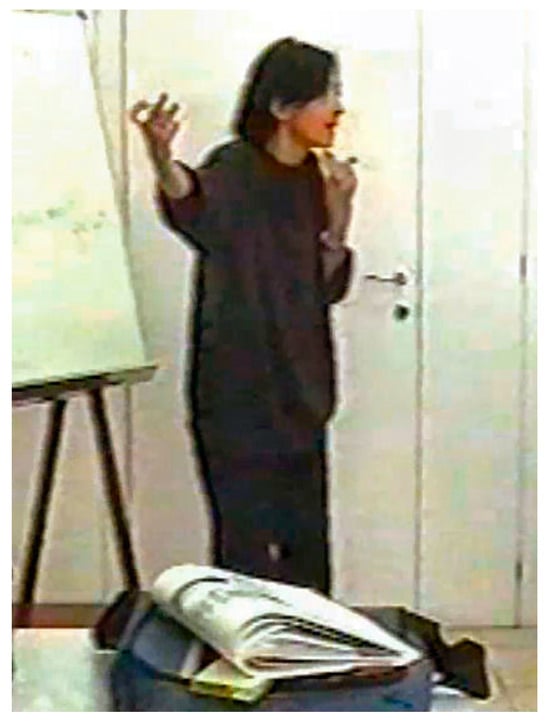
Figure 18.
Teacher explaining the use of the imperfect tense in Italian: no matter how long ago the action happened or how long it lasted, “who cares?”.
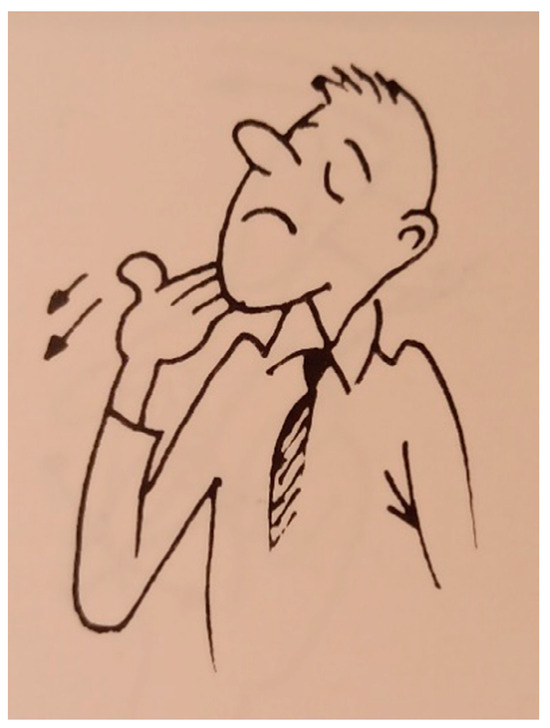
Figure 19.
Italian gesture to express “I don’t care” or “who cares?” (“chi se ne frega”).
3.4. Mirroring Effect in Teacher/Students’ Interaction
CLODIS has been designed to offer a wide range of examples of teacher talk in L2 Italian classrooms, and the camera generally frames a teacher with the students taken from their back for a number of reasons, including privacy. Therefore, it is impossible to detect mirroring gestures (teachers imitating students, and vice versa). On the other hand, how the embodied action of laughter is often mirrored and shared in teacher–student interactions has been studied (Diadori 2022)21. This is also an embodied action that gives an idea of how important it is to observe the behavior of the participants to understand their rapport, their mutual understanding, and their sub-conscious tendency to imitate each other.
Students may also imitate emblems used by native L2 teachers, as has sometimes been observed in CLODIS when the teacher’s mother tongue is Italian. In this instance, emblems are often scattered among a variety of other gesture types that teachers use when addressing the class (like in Example 11). If students imitate them without understanding that they are not simple body movements but rather have specific functions that correspond to specific registers in interaction, misunderstandings may arise. I can personally remember the case of a northern European student who used to accompany her speech in Italian with the “purse/pinched fingers” gesture (n.4 in Figure 20). This is probably the most common symbolic gesture used in Italy nowadays, made by stretching the right hand fingers and gathering them in order to form a pinecone with the point upwards, then moving it up and down. It is very informal and usually accompanies questions like “What are you doing here?” or “What do you want?”, with more or less friendly intentions. For this reason, the foreign student using it constantly when communicating in Italian was probably not aware of its meaning and of the disagreeable feeling it caused in her Italian interlocutors. Mirroring, in this case, had caused a kind of “hyper-culturalization”, and should have been framed into a deeper knowledge of the wide variety of symbolic gestures used in contemporary Italy as part of a communicative and pragmatic learning approach to the Italian language and culture (Diadori 2002, 2013).
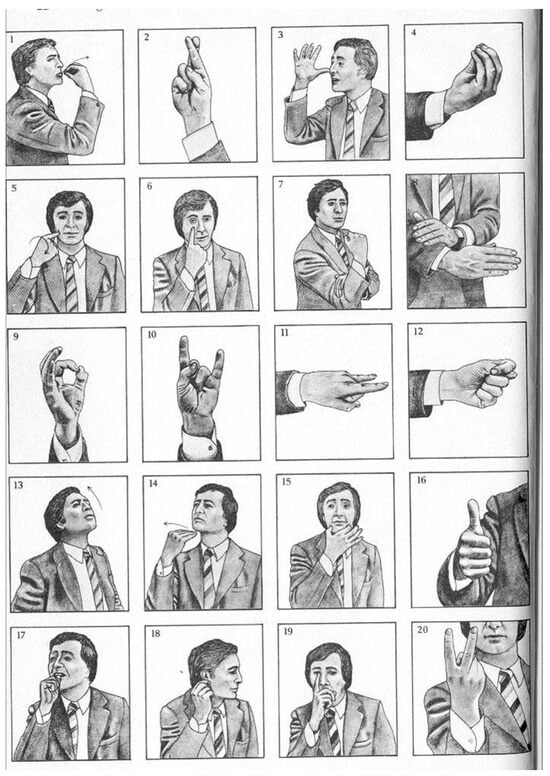
Figure 20.
A selection of gestures used in Europe and in the Mediterranean area (Morris et al. 1979).
4. Discussion
This study of L2 teachers’ and students’ gestures in the classroom has pointed out that it is certainly useful to pay attention to them as a part of the embodied actions that accompany speech for L2 teaching and learning purposes. Both previous data-based research on multimodality in L2 classes and this analysis on CLODIS Italian L2 corpus show that teachers select and coordinate multiple semiotic modes as interactional resources to achieve various teaching tasks (organizing turn taking, explaining, giving instructions, appraising, giving error feedback, etc.) to attract students’ attention, to create space for thinking, to facilitate understanding, and to promote memorization.
Teachers use pedagogical gestures in all L2 teaching contexts, as the literature review has proved, but when the L2 teacher is native of a particularly gesticulative culture, the situation becomes more complex. This is the case for L2 Italian language native teachers, who need to be aware of the double tension between standardizing their talk to make it comprehensible for foreign students and behaving naturally, both in their use of language and in their culturally specific embodied actions. When the target language/culture incorporates a certain number of “emblems”—as is the case in Italian L2—it has been observed that native teachers may use them unconsciously with the risk of being misunderstood or of not being noticed. On the other hand, they may introduce them in content-based instructions—together with their verbal meaning, the corresponding register, and their pragmatic effects in conversation—in order to make students aware of this important semiotic code that may accompany or replace speech in the target culture.
Nonverbal communication for L2 teaching purposes with non native interlocutors includes a wide range of scaffolding techniques and is not innate. Therefore, it is relevant that prospective teachers and in-service teachers focus on the purpose and effects of their embodied actions in the classroom (eye gaze, posture and use of the body, laughter, silent pauses, voice modulation, and rhythm) and on what their students’ embodied actions reveal about their learning process. Teachers should develop multimodal awareness both during their training and their in-service activity through the analysis of video-recorded lessons, in which verbal and embodied actions occur. An increasing interest in the importance of developing nonverbal pedagogical competence in teacher training is shared by numerous scholars22, who are convinced that the effective use of the body as a pedagogical tool is an important element of quality teaching and is to be developed through theory and practice, through self-observation, and through the assessment of one’s teaching performances by students, colleagues, and experts.
The case study presented in this paper was certainly descriptive and not exhaustive, having considered only Italian teachers’ gestures and not the gestures of students. Nevertheless, the selection of representative gestures of Italian native teachers taken from CLODIS Italian L2 corpus presented in this paper, although limited, has confirmed what has also been observed in other contexts (as shown in the introduction), i.e., the variety of multimodal resources that language teachers employ when addressing students with limited knowledge of the target language. Moreover, it has allowed us to focus on the specificity of metaphorical gestures (the so-called “emblems”) that are part of the Italian culture and that may not be easily interpreted compared to the iconic gestures that all teachers use. Therefore, this pilot work suggests that future studies could take advantage of larger corpus-based multimodal analyses, which may allow not only for comparison to the nonverbal behavior of native language teachers in those countries—like Italy—that belong to the so-called “high-contact cultures”, as described in Desmond Morris seminal studies23, but also observation of the mirroring effects that such “emblems” produce in students due to their cultural value and their widespread presence in mass media and communication between natives.
Funding
This research received no external funding.
Institutional Review Board Statement
The study did not require ethical approval.
Informed Consent Statement
Informed consent was obtained from all subjects involved in the study.
Data Availability Statement
CLODIS videorecorded data are available upon request at the DITALS research and Service Centre of the Università per Stranieri di Siena (www.unistrasi.it, accessed on 17 April 2024).
Conflicts of Interest
The author declares no conflict of interest.
Appendix A
CLODIS transcriptions, from which the fragments of speech of chapter 3 are taken, use the following notation symbols (Jefferson 1984, 2004):
| Brief pause, usually between 0.08 and 0.2 s | (.) |
| Longer pauses (0.2, 0.5, 0.7, 1.0 s, etc.) | (0.2) |
| Underlining indicates emphasis | text |
| Upper case indicates syllables or words louder than surrounding speech by the same speaker | TEXT |
| Degree signs indicate syllables or words distinctly quieter than surrounding speech by the same speaker | °text° |
| Falling intonation | text. |
| Flat intonation | text_ |
| Slight rising intonation | text, |
| Sharp rising intonation | text? |
| Colon indicates prolonged vowel | te:xt |
| Marked shift in pitch, up (↑) or down (↓). Double arrows can be used with extreme pitch shifts. | ↑text ↓text |
| Right/left carats indicate increased speaking rate (speeding up) | >text< |
| Left/right carats indicate decreased speaking rate (slowing down) | <text> |
| Double parentheses contain analyst comments or descriptions | (( )) |
| Parentheses indicate uncertain text | (text) |
| Parentheses and asterisks indicate inintelligible text | (***) |
| Overlapping talk | [text] [text] |
| End of turn and beginning of the next one with no gap/pause in between | = |
The following abbreviations and symbols have been added to more precisely represent L2 classroom interactions:
| Parts in bold are used to identify the section of text considered for analysis | text |
| Text in a different language, code-switching | “text” |
| Reported word or sentence | text |
| Nonverbal communication and symultaneous speech (CNV Comunicazione Non Verbale) | ((CNV) text) |
| Female teacher (DF Docente Femmina) | DF |
| Male teacher (DM Docente Maschio) | DM |
| Female student (FS Studentessa Femmina) | SF |
| Male student (SM Studente Maschio) | SM |
| Class | CLA |
Notes
| 1 | Recent cognitive studies consider gestures as simulated actions, a kind of visible embodiment that arise from an embodied cognitive system and mental imagery (Hostetter and Alibali 2008). On the deep connection of gesture, speech and cognition see also (McNeill 1992, 2000, 2005). |
| 2 | A holistic approach to gestures in second language acquisition and classroom research can be found in various introductory studies like (McCafferty and Stam 2009, chap. 5). |
| 3 | For English L2 see, among others, (Hauge 1998, 1999, 2000; Lazaraton 2004; Wanphet 2015; Matsumoto and Mueller Dobs 2016; Matsumoto 2019; Yamane et al. 2019). For Italian L2 see (Peltier and McCafferty 2010; Tummillo 2016; Ery and Huszthy 2017; Bianchi and Diadori 2018; Huszthy 2020; Capponi 2022). For French L2 see (Faraco 2010; Saydi 2010; Azaoui 2014; Tellier et al. 2021). For German L2 see (Heidemann 1983; Kodakos 1992; Rosenbusch 1995; Hammer 1995; Kaiser 1998). For Spanish L2 see (Cestero 1999, 2017; Belío-Apaolaza and Hernández Muñoz 2021). A comparison between gestures in teaching Italian L2 and Korean L2 in Korea is offered in (Mondin 2022). On gestures in teaching German L2 and Persian L2 in the USA see (Taleghani-Nikazm 2008). |
| 4 | (Efron 1941; Ekman and Friesen 1969; Kendon 1980, 2004), just to name the most relevant ones. |
| 5 | An example on algebra lessons facilitated by the use of gestures as scaffolding technique in (Alibali and Nathan 2007). |
| 6 | On students’ embodied actions cf. (Gullberg 1998, 2008, 2014; Gullberg and McCafferty 2008; Goldin-Meadow and Alibali 2013). |
| 7 | “Interlanguage” is the idiolect of an L2 student, containing some aspects of the L2, some of the L1 or other familiar languages, and some that are due to one’s own hypothesis of how L2 functions (Selinker 1972; Tarone and Han 2014). |
| 8 | On students’ gestures as visible representation of their cognitive activity cf. (McNeill 1992, 2000; Kita 2000; Goldin-Meadow 2003, 2004; Olsher 2008; Ianì and Formichella 2017; De Iaco 2020). For a scientifically based argument on the connection of gesture and speech from a neurological point of view, see (Willems et al. 2007). |
| 9 | On the positive impact of gestures on L2 listening comprehension cf. (Kellerman 1992; Sueyoshi and Hardison 2005; Tellier 2009). |
| 10 | On misunderstandings due to symbolic or culturally specific gestures cf. (Azaoui 2014; Hauge 1998, 1999; Sime 2006, 2008; Tellier 2008a, 2009). |
| 11 | See, for example, (Matsumoto and Hwang 2013) for cultural differences in emblematic gestures and Pika’s studies (e.g., Pika et al. 2006) for cultural differences using gestures in specific contexts. |
| 12 | On teachers’ gestures in the L2 Italian classroom see, among others, (Diadori 2002, 2013; Ery and Huszthy 2017; Capponi 2022). |
| 13 | CLODIS—Corpus di Lingua Orale dei Docenti di Italiano per Stranieri (described in Diadori and Monami 2020; Diadori 2021) is a audiovisual database which is part of a research project on Italian language teaching, directed by Pierangela Diadori at the Università per Stranieri di Siena. An appendix with CLODIS transcription symbols can be found at the end of this paper. |
| 14 | For this study, all the selection, recording, and coding processes were conducted by the author, who has extensive experience in the subject. |
| 15 | See (Krashen 1985) for the hypothesis of “comprehensible input” in foreign language teaching. |
| 16 | The images of LIS signs are taken from Angelini et al. (1991). On Italian LIS see also (Volterra 2004). |
| 17 | This representation is to be found also in an essay on Neapolitan gestures of the XIX century (De Iorio 1832), and in (Angelini et al. 1991). |
| 18 | 100 contemporary Italian emblems are described in (Diadori 1990) (see also Caon 2010; Nobili 2023). On symbolic gestures that occur sometimes with the same form but with different meanings in various cultures, see (Morris 1994) and on nonverbal cross-cultural differences (Kita 2009). |
| 19 | The image of the chin flick gesture expressing “I don’t care” is taken from Diadori (1990, p. 54). |
| 20 | According to (Morris et al. 1979), who investigated in their different meanings these 20 gestures by interviewing 1200 informants in 40 towns all over Europe, the chin flick gesture, also attested in De Iorio (1832), is mostly used in Italy with the meaning of “I don’t care” but also as a negative answer, especially in southern Italy. In the rest of Europe either it is not used (half of the informants) or it is used with different meanings. |
| 21 | On the role of laughter in interaction see also (Glenn 2003). |
| 22 | On the importance of nonverbal pedagogical competence in teacher training see, among others, (Heidemann 1983; Neill and Caswell 1993; Freeman and Johnson 1998; Alibali et al. 2013; Tellier and Cadet 2014; Cestero 2017; Tellier et al. 2021; Stam and Tellier 2022). |
| 23 | Southern European, Mediterranean, and Latin American countries are traditionally referred to as “high-contact cultures”, where people tend to use more gestures, touch each other more often, maintain closer interpersonal distance, make more eye contact, and speak louder, as opposed to “low-contact cultures” of Northern European, Northern American, and Eastern countries (Morris et al. 1979, e.g., considered 20 “emblems” in 25 countries in the Mediterranean area). |
References
- Abner, Natasha, Kensy Cooperrider, and Susan Goldin-Meadow. 2015. Gesture for Linguists: A Handy Primer. Language and Linguistics Compass 9: 437–49. [Google Scholar] [CrossRef] [PubMed]
- Alibali, Martha W., and Mitchell J. Nathan. 2007. Teachers’ gestures as a means of scaffolding students’ understanding: Evidence from an early algebra lesson. In Video Research in the Learning Sciences. Edited by Ricki Goldman, Roy Pea, Brigid Barron and Sharon J. Derry. Mahwah: Erlbaum, pp. 349–65. [Google Scholar]
- Alibali, Martha W., Andrew G. Young, Noelle M. Crooks, Amelia Yeo, Matthew S. Wolfgram, Jasmine M. Ledesma, Mitchel J. Nathan, Ruth Breckinridge Church, and Eric J. Knuth. 2013. Students learn more when their teacher has learned to gesture effectively. Gesture 13: 210–33. [Google Scholar] [CrossRef]
- Alibali, Martha W., Dana C. Heath, and Heather J. Myers. 2001. Effects of visibility between speaker and listener on gesture production: Some gestures are meant to be seen. Journal of Memory and Language 44: 169–88. [Google Scholar] [CrossRef]
- Allen, Linda Q. 1995. The effects of emblematic gestures on the development and access of mental representations of French expressions. The Modern Language Journal 79: 521–29. [Google Scholar] [CrossRef]
- Allen, Linda Q. 2000. Nonverbal accommodations in foreign language teacher talk. Applied Language Learning 11: 155–76. [Google Scholar]
- Angelini, Natalia, Rossano Borgioli, Anna Folchi, and Matteo Mastromatteo, eds. 1991. I Primi 400 Segni. Piccolo Dizionario Della Lingua Italiana dei Segni per Comunicare con i Sordi. Firenze: La Nuova Italia. [Google Scholar]
- Arnold, Lynnette. 2012. Dialogic embodied action. Using gesture to organize sequence and participation in instructional interaction. Resarch on Language & Social Interaction 45: 269–96. [Google Scholar]
- Azaoui, Brahim. 2014. Multimodalité des signes et enjeux énonciatifs en classe de FL1/FLS. In Le Corp et la Voix de L’enseignant: Mise en Context Théorique et Pratique. Edited by Marion Tellier and Lucile Cadet. Paris: Maison des Langues, pp. 115–26. [Google Scholar]
- Belío-Apaolaza, Helena S., and Natividad Hernández Muñoz. 2021. Emblematic gestures learning in Spanish as L2/FL: Interactions between types of gestures and tasks. Language Teaching Research 7: 1–33. [Google Scholar] [CrossRef]
- Bianchi, Valentina, and Pierangela Diadori. 2018. Gesti di tempo nella classe di italiano L2. SILTA—Studi Italiani di Linguistica Teorica e Applicata XLVII: 293–316. [Google Scholar]
- Caon, Fabio. 2010. Dizionario dei Gesti Degli Italiani. Una Prospettiva Interculturale. Perugia: Guerra. [Google Scholar]
- Capponi, Lavinia. 2022. Grammatiche del corpo. Un percorso sulla gestualità nella didattica dell’italiano L2. LIA Lingua in Azione 1–2: 47–56. [Google Scholar]
- Cestero, Ana M. 1999. La Comunicación no Verbal y Enseñanza de Lenguas Extranjeras. Madrid: Arco Libros. [Google Scholar]
- Cestero, Ana M. 2017. La Comunicación no Verbal, In Manual del Profesor de ELE. Edited by Ana M. Cestero Mancera and Immaculada Penadés Martínez. Alcalá de Henares: Universidad de Alcalá, pp. 1051–122. [Google Scholar]
- Cooperrider, Kensy, and Susan Goldin-Meadow. 2017. Gesture, Language, and Cognition. In Cambridge Handbook of Cognitive Linguistics. Edited by Barbara Dancygier. Cambridge: Cambridge University Press, pp. 118–34. [Google Scholar]
- Dahl, Tove I., and Susanne Ludvigsen. 2014. How I see what you’re saying: The role of gestures in native and foreign language listening comprehension. The Modern Language Journal 98: 813–33. [Google Scholar] [CrossRef]
- De Iaco, Moira. 2020. Mani che aiutano ad apprendere. Gesti, lingue, educazione linguistica. Lecce: Pensa Multimedia. [Google Scholar]
- De Iorio, Andrea. 1832. La Mimica Degli Antichi Investigata nel Gestire Napoletano. Napoli: Associazione Napoletana per i Monumenti e il Paesaggio. [Google Scholar]
- Diadori, Pierangela. 1990. Senza Parole. 100 Gesti Degli Italiani. Roma: Bonacci. [Google Scholar]
- Diadori, Pierangela. 2002. La gestualità nell’insegnamento dell’italiano lingua straniera. In La Competenza Linguistica in Italiano: Non Solo Parole. Edited by Marie-Reine Blommaert. Brussels: Studiereek Interfacultair Departement voor Taalonderwijs, Vrije Universiteit, pp. 23–65. [Google Scholar]
- Diadori, Pierangela. 2013. Gestualità e didattica della seconda lingua: Questioni interculturali. In Aspetti Comunicativi e Interculturali Nell’insegnamento delle Lingue. Edited by Enrico Borello and Maria Cecilia Luise. Alessandria: Edizioni dell’Orso, pp. 71–102. [Google Scholar]
- Diadori, Pierangela. 2021. CLODIS. Una banca dati di natura multimodale per l’insegnamento dell’italiano L2. In La Nuova DITALS Risponde. Edited by Pierangela Diadori. Roma: Edilingua, pp. 504–9. [Google Scholar]
- Diadori, Pierangela. 2022. Ridere nella classe di italiano L2: Non solo humor. Un’indagine corpus-based in contesti universitari in Italia e all’estero. RISU Rivista Italiana di Studi sull’Umorismo 5: 31–46. [Google Scholar]
- Diadori, Pierangela, and Elena Monami. 2020. CLODIS: Una banca dati multimodale per la formazione dei docenti di italiano L2. RID—Rivista Italiana di Dialettologia. Lingue, Dialetti, Società XLIV: 151–69. [Google Scholar]
- Efron, David. 1941. Gesture and Environment. New York: King’S Crown Press. [Google Scholar]
- Ekman, Paul, and Wallace Friesen. 1969. The Repertoire of Nonverbal Behavior: Categories, Origins, Usage, and Coding. Semiotica 1: 49–98. [Google Scholar] [CrossRef]
- Ery, Anna, and Alma Huszthy. 2017. Le caratteristiche verbali e non verbali della comunicazione dell’insegnante di italiano. In Presente e Futuro Della Lingua e Letteratura Italiana: Problemi, Metodi, Ricerche. Edited by Elena Pîrvu. Firenze: Cesati, pp. 383–94. [Google Scholar]
- Eskildsen, Søren W., and Johannes Wagner. 2013. Recurring and shared gestures in the L2 classroom: Resources for teaching and learning. European Journal of Applied Linguistics 1: 139–61. [Google Scholar] [CrossRef]
- Faraco, Martine. 2010. Geste et prosodie didactiques dans l’enseignement des structures langagières en FLE. In Enseigner les Structures Langagières en FLE. Edited by Olga Galatanu, Michel Pierrard, Dan Van Raemdonck, Marie-Eve Damar, Nancy Kemps and Ellen Schoonheere. Brussels: Peter Lang, pp. 203–12. [Google Scholar]
- Freeman, Donald, and Karen E. Johnson. 1998. Reconceptualizing the knowledge-base of language teacher education. TESOL Quarterly 32: 397–417. [Google Scholar] [CrossRef]
- Galati, Alexia, and Susan E. Brennan. 2013. Speakers adapt gestures to addressees’ knowledge: Implications for models of co-speech gesture. Language and Cognitive Processes 29: 435–51. [Google Scholar] [CrossRef]
- García-Gámez, Ana B., and Pedro Macizo. 2023. Gestures as Scaffolding to Learn Vocabulary in a Foreign Language. Brain Sciences 13: 1712. [Google Scholar] [CrossRef] [PubMed]
- Glenn, Phillip. 2003. Laughter in Interaction. Cambridge: Cambridge University Press. [Google Scholar]
- Goldin-Meadow, Susan. 2003. Hearing Gesture: How Our Hands Help Us to Think. Cambridge, MA: The Belknap Press of Harvard University Press. [Google Scholar]
- Goldin-Meadow, Susan. 2004. Gesture’s Role in the Learning Process. Theory into Practice 43: 314–21. [Google Scholar] [CrossRef]
- Goldin-Meadow, Susan, and Martha W. Alibali. 2013. Gesture’s role in speaking, learning, and creating language. Annual Review of Psychology 64: 257–83. [Google Scholar] [CrossRef]
- Grant, Barbara, and Dorothy Grant Hennings. 1971. The Teacher Moves: An Analysis of Non-Verbal Activity. Theory and Research in Teaching. New York: Teachers College Press. [Google Scholar]
- Graziano, Maria, and Marianne Gullberg. 2013. Gesture production and speech fluency in competent speakers and language learners. In Proceedings of the Tilburg Gesture Research Meeting (TiGeR). Tilburg: Tilburg University. [Google Scholar]
- Gullberg, Marianne. 1998. Gesture as a Communication Strategy in Second Language Discourse. Lund: Lund University Press. [Google Scholar]
- Gullberg, Marianne. 2008. Gestures and second language acquisition. In Handbook of Cognitive Linguistics and Second Language Acquisition. Edited by Nick C. Ellis and Peter Robinson. London: Routledge, pp. 276–305. [Google Scholar]
- Gullberg, Marianne. 2014. Gestures and second language acquisition. In Body-Language-Communication: An International Handbook on Multimodality in Human Interaction. Edited by Cornelia Müller, Alan J. Cienki, Ellen Fricke, Silva H. Ladewig, David McNeill and Sedinha Tessendorf. Berlin: De Gruyter, pp. 1868–75. [Google Scholar]
- Gullberg, Marianne, and Steven G. McCafferty. 2008. Introduction to Gesture and SLA: Toward an Integrated Approach. Studies in Second Language Acquisition 30: 133–46. [Google Scholar] [CrossRef]
- Hall, Joan K., and Stephen D. Looney, eds. 2019. The Embodied Work of Teaching. Bristol: Multilingual Matters. [Google Scholar]
- Hall, Joan K., and Tetyana Smotrova. 2013. Teacher self-talk: Interactional resource for managing instruction and eliciting sympathy. Journal of Pragmatics 47: 75–92. [Google Scholar] [CrossRef]
- Hammer, Wolfgang. 1995. Körpersprache des Lehrers. Rostocker Pädagogische Hefte; Rostock: LISA Studienseminar Rostock für Gymnasien/Landesbildstelle. [Google Scholar]
- Hauge, Elisabeth. 1998. Gesture in the EFL class: An aid to communication or a source of confusion? In Crosscultural Capability. Edited by Danielle Killik and Mike Parry. Leeds: Leeds Metropolitan University, pp. 271–80. [Google Scholar]
- Hauge, Elisabeth. 1999. Some common emblems used by British English teachers in EFL classes. In Crosscultural Capability. Promoting the Discipline. Edited by Danielle Killik and Mike Parry. Leeds: Leeds Metropolitan University, pp. 405–20. [Google Scholar]
- Hauge, Elisabeth. 2000. The Role of Gesture in British ELT in a University Setting. Southampton: University of Southampton. [Google Scholar]
- Heidemann, Rudolf. 1983. Körpersprache vor der Klasse. Ein praxisnahesTrainingsprogramm zum Lehrerverhalten. Heidelberg: Quelle. [Google Scholar]
- Hostetter, Autumn B., and Martha W. Alibali. 2008. Visible Embodiment: Gestures as Simulated Action. Psychonomic Bulletin and Review 15: 495–514. [Google Scholar] [CrossRef]
- Huszthy, Alma. 2020. La comunicazione dell’insegnante durante la lezione d’italiano in contesto scolastico ungherese: Caratteristiche comuni e strategie individuali. ItalianoLinguaDue 2: 299–312. [Google Scholar]
- Ianì, Francesco, and Marco Formichella. 2017. Il ruolo cognitivo dei gesti. Giornale Italiano di Psicologia 4: 849–76. [Google Scholar]
- Jefferson, Gail. 1984. Transcription Notation. In Structures of Social Interaction. Edited by John Atkinson and John Heritage. New York: Cambridge University Press, pp. ix–xvi. [Google Scholar]
- Jefferson, Gail. 2004. Glossary of transcript symbols with an introduction. In Conversation Analysis: Studies from the First Generation. Edited by Gene H. Lerner. Amsterdam: John Benjamins, pp. 13–31. [Google Scholar]
- Jenkins, Susan, and Isabel Parra. 2003. Multiple layers of meaning in an oral proficiency test. The complementary role of nonverbal, paralinguistic and verbal behaviors in assessment decisions. Modern Language Journal 87: 90–107. [Google Scholar] [CrossRef]
- Käänta, Leila. 2012. Teacher’s embodied allocations in instructional interaction. Classroom Discourse 3: 166–86. [Google Scholar] [CrossRef]
- Kaiser, Constanze. 1998. Körpersprache der Schüler. München: Luchtenhand. [Google Scholar]
- Kang, Seokmin, Gregory L. Hallman, Lisa K. Son, and John B. Black. 2013. The different benefits from different gestures in understanding a concept. Journal of Science Education and Technology 22: 825–37. [Google Scholar] [CrossRef]
- Kellerman, Susan. 1992. “I see what you mean”. The role of kinesic behavior in listening and implications for foreign and second language learning. Applied Linguistics 13: 239–58. [Google Scholar] [CrossRef]
- Kelly, Spencer D., Dale J. Barr, Ruth Beckinridge Church, and Katheryn Lynch. 1999. Offering a hand to pragmatic understanding: The role of speech and gesture in comprehension and memory. Journal of Memory and Language 40: 577–92. [Google Scholar] [CrossRef]
- Kendon, Adam. 1980. Gesticulation and Speech. Two aspects of the process of utterance. In The Relationship of Verbal and Nonverbal Communication. Edited by Mary R. Key. The Hague: Mouton, pp. 207–27. [Google Scholar]
- Kendon, Adam. 1995. Gestures as illocutionary and discourse structure markers in Southern Italian conversation. Journal of Pragmatics 23: 247–79. [Google Scholar] [CrossRef]
- Kendon, Adam. 2004. Gesture. Visible Action as Utterance. Cambridge: Cambridge University Press. [Google Scholar]
- Kita, Sotaro. 2000. How representational gestures help speaking. In Language and Gesture: Window into Thought and Action. Edited by David McNeill. Cambridge: Cambridge University Press, pp. 162–85. [Google Scholar]
- Kita, Sotaro. 2009. Cross-cultural variation of speech-accompanying gesture: A review. Language and Cognitive Processes 24: 145–67. [Google Scholar] [CrossRef]
- Kodakos, Anastassios. 1992. Zur Körpersprache des Lehrers im Unterricht. Stuttgart: Flugschriften der Volkshochschule Stuttgart, vol. 9. [Google Scholar]
- Krashen, Stephen D. 1985. The Input Hypothesis: Issues and Implications. London: Longman. [Google Scholar]
- Krauss, Robert M., and Ezequiel Morsella. 2001. Movements Facilitates Speech Production: A Gestural Feedback Model. New York: Cambridge University Press. [Google Scholar]
- Lazaraton, Anne. 2004. Gesture and Speech in the vocabulary explanations of one ESL teacher: A Microanalytic Inquiry. Language Learning 54: 79–117. [Google Scholar] [CrossRef]
- Macedonia, Manuela, and Wolfgang Klimesch. 2014. Long-term effects of gestures on memory for foreign language word trained in the classroom. Mind, Brain and Education 8: 74–88. [Google Scholar] [CrossRef]
- Mackey, Alison, Susan Gass, and Kim McDonough. 2000. How do learners perceive interactional feedback? Studies in Second Language Acquisition 22: 471–97. [Google Scholar] [CrossRef]
- Majlesi, Reza, and Numa Markee. 2018. Multimodality in Second Language Talk: The Impact of Video Analysis on SLA Research. Tartu Semiotics Library 19: 247–60. [Google Scholar]
- Markee, Numa, ed. 2015. The Handbook of Classroom Discourse and Interaction. Oxford: Wiley Blackwell. [Google Scholar]
- Matsumoto, David, and Hyi Sung Hwang. 2013. Cultural influences on nonverbal behavior. In Nonverbal Communication: Science and Applications. Edited by David Matsumoto, Mark G. Frank and Hyi Sung Hwang. Thousand Oaks: Sage Publications, pp. 97–120. [Google Scholar]
- Matsumoto, Yumi. 2019. Embodied Actions and Gestures as Interactional Resources for Teaching in a Second Language Writing Classroom. In The Embodied Work of Teaching. Edited by Joan K. Hall and Stephen D. Looney. Bristol: Multilingual Matters, pp. 9–23. [Google Scholar]
- Matsumoto, Yumi, and Abby Mueller Dobs. 2016. Pedagogical gestures as interactional resources for teaching and learning tense and aspect in the ESL grammar classroom. Language Learning 67: 7–42. [Google Scholar] [CrossRef]
- McCafferty, Steven G. 2002. Gesture and Creating Zones of Proximal Development for Second Language Learning. The Modern Language Journal 86: 192–203. [Google Scholar] [CrossRef]
- McCafferty, Steven G., and Gale Stam, eds. 2009. Gesture: Second Language Acquisition and Classroom Research. London: Routledge. [Google Scholar]
- McNeill, David. 1992. Hand and Mind: What Gesture Reveal about Thought. Chicago: University of Chicago Press. [Google Scholar]
- McNeill, David, ed. 2000. Language and Gesture. Window into Thought and Action. Cambridge: Cambridge University Press. [Google Scholar]
- McNeill, David. 2005. Gesture and Thought. Chicago: University of Chicago Press. [Google Scholar]
- Mondada, Lorenza. 2007. Multimodal resources for turn-taking: Pointing and the emergence of possible next speaker. Discourse Studies 9: 194–225. [Google Scholar] [CrossRef]
- Mondada, Lorenza. 2014. Pointing, talk, and the bodies. Reference and joint attention as embodied interactional achievements. In From Gesture in Conversation to Visible Action as Utterance. Edited by Mandana Seyfeddinipur and Marianne Gullberg. Amsterdam: John Benjamins, pp. 95–126. [Google Scholar]
- Mondin, Lisa. 2022. Il ruolo del linguaggio non verbale nella didattica delle lingue. Analisi della gestualità utilizzata dai docenti italiani e coreani nelle lezioni. Mater’s thesis, Università per Stranieri di Siena, Siena, Italy. [Google Scholar]
- Morris, Desmond. 1994. Bodytalk. A World Guide to Gestures. London: Cape. [Google Scholar]
- Morris, Desmond, Peter Collett, Peter Marsh, and Marie O’Shaughnessy. 1979. Gestures. London: Cape. [Google Scholar]
- Neill, Sean, and Chris Caswell. 1993. Body Language for Competent Teachers. London: Routledge. [Google Scholar]
- Neu, Joyce. 1990. Assessing the role of nonverbal communication in the acquisition of communicative competence in L2. In Developing Communicative Competence in a Second Language. Edited by Robin C. Scarcella, Elaine S. Andersen and Stephen D. Krashen. New York: Newbury House, pp. 121–38. [Google Scholar]
- Nobili, Claudio. 2023. L’italiano Senza Parole: Segni, Gesti, Silenzi. Firenze: Cesati. [Google Scholar]
- Núñez, Rafael, and Kensy Cooperrider. 2013. The tangle of space and time in human cognition. Trends in Cognitive Sciences 17: 220–29. [Google Scholar] [CrossRef]
- Olsher, David. 2008. Gesturally-enhanced repeats in the repair turn: Communication strategy or cognitive language-learning tool? In Gesture. Second Language Acwuisition and Classroom Research. Edited by Steven G. McCafferty and Gale Stam. New York: Routledge, pp. 109–30. [Google Scholar]
- Park, Jaeuk. 2017. Multimodality as an Interactional Resource for Classroom Interactional Competence. Linguistics 3: 121–38. [Google Scholar] [CrossRef]
- Peltier, Ilaria Nardotto, and Steven G. McCafferty. 2010. Gesture and identity in the teaching and learning Italian. Mind, Culture and Activity 17: 331–49. [Google Scholar] [CrossRef]
- Pika, Simone, Elena Nicoladis, and Paula F. Marentette. 2006. A cross-cultural study on the use of gestures: Evidence for cross-linguistic transfer? Bilingualism: Language and Cognition 9: 319–27. [Google Scholar] [CrossRef]
- Poggi, Isabella. 2006. Le parole del Corpo. Introduzione alla Comunicazione Multimodale. Roma: Carocci. [Google Scholar]
- Rosenbusch, Heinz S. 1995. Nonverbale Kommunikation im Unterricht. In Körpersprache in der Schulische Erziehung. Edited by Heinz S. Rosenbusch and Otto Schober. Baltmannsweiler: Schneider. [Google Scholar]
- Saydi, Tilda. 2010. Mimogestualité: Une composante pragmatique pour les apprenants du FLE. Synergies Turquie 3: 205–13. [Google Scholar]
- Selinker, Larry. 1972. Interlanguage. International Review of Applied Linguistics in Language Teaching 10: 209–32. [Google Scholar] [CrossRef]
- Seo, Mi-Suk, and Irene Koshik. 2010. A conversation analytic study of gestures that engender repair in EFL conversational tutoring. Journal of Pragmatics 42: 2219–39. [Google Scholar] [CrossRef]
- Sert, Olcay. 2015. Social Interaction and L2 Classroom Discourse. Edinburgh: Edinburgh University Press. [Google Scholar]
- Seymen, Aylin. 2014. Einsatz der Körpersprache im Fremdsprachenunterricht. International Journal of Language Academy 2: 546–53. [Google Scholar] [CrossRef]
- Sime, Daniela. 2006. What do learners make of teacher’s gestures in the language classroom? International Review of Applied Linguistics 44: 211–30. [Google Scholar] [CrossRef]
- Sime, Daniela. 2008. Because of her gesture, it’s easy to understandd. Learners’ perception of teachers’ gestures in the foreign language class. In Gesture: Second Language Acquisition and Classroom Research. Edited by Steven G. McCafferty and Gale Stam. New York: Routledge, pp. 259–79. [Google Scholar]
- Smotrova, Tetyana. 2017. Making Pronunciation Visible: Gesture in Teaching Pronunciation. TESOL Quarterly 51: 59–89. [Google Scholar]
- Smotrova, Tetyana, and James P. Lantolf. 2013. The function of gesture in lexically focused L2 instructional conversations. The Modern Language Journal 97: 397–416. [Google Scholar] [CrossRef]
- Stam, Gale. 2008. What gestures reveal about second language acquisition. In Gesture: Second Language Acquisition and Classroom Research. Edited by Steven G. McCafferty and Gale Stam. New York: Routledge, pp. 231–55. [Google Scholar]
- Stam, Gale. 2012. Gestes et recherche de mots en langue seconde. In La Corporalité du Langage: Multimodalité, Discours et Écriture. Edited by Robert Vion, Alain Giacomi and Claude Vargas. Aix-en-Provence: Université de Provence, pp. 55–71. [Google Scholar]
- Stam, Gale. 2016. Gesture as a window onto conceptualization on multiple tasks: Implications for second language teaching. Yearbook of the German Cogitive Association 4: 289–314. [Google Scholar] [CrossRef]
- Stam, Gale. 2018. Gesture and speaking a second language. In Speaking in a L2. Edited by Rosa Alonso Alonso. Amsterdam: John Benjamins, pp. 51–69. [Google Scholar]
- Stam, Gale, and Marion Tellier. 2017. The sound of silence: The functions of gestures in pauses in native and non-native interaction. In Why Gesture? How the Hands Function in Speaking, Thinking and Communicating. Edited by Ruth Breckinridge Church, Martha W. Alibali and Spencer D. Kelly. Amsterdam: John Benjamins, pp. 353–77. [Google Scholar]
- Stam, Gale, and Marion Tellier. 2022. Gesture helps second and foreign language learning and teaching. In Gesture in Language: Development Across the Lifespan. Edited by Aliyah Morgenstern and Susan Goldin-Meadow. Berlin: De Gruyter Mouton, pp. 335–63. [Google Scholar]
- Sueyoshi, Ayano, and Debra M. Hardison. 2005. The role of gestures and facial cues in second language listening comprehension. Language Learning 55: 661–99. [Google Scholar] [CrossRef]
- Tabensky, Alexis. 2008. Expository discourse in a second language classroom: How learners use gesture. In Gesture: Second Language Acquisition and Classroom Research. Edited by Steven G. McCafferty and Gale Stam. New York: Routledge, pp. 298–320. [Google Scholar]
- Taleghani-Nikazm, Carmen. 2008. Gestures in Foreign Language Classroom: An Empirical Analysis of their Organization and Function. In Selected Proceedings of the 2007 Second Language Research Forum. Edited by Melissa Bowles, Rebecca Foote, Silvia Perpiñán and Rakesh Mohan Bhatt. Somerville: Cascadilla Proceedings Project, pp. 229–38. [Google Scholar]
- Tarone, Elaine, and ZhaoHong Han, eds. 2014. Interlanguage. Fourty Years Later. Amsterdam: John Benjamins. [Google Scholar]
- Tellier, Marion. 2008a. Dire avec des gestes. Français dans le Monde. Recherche et Application 44: 219–35. [Google Scholar]
- Tellier, Marion. 2008b. The effect of gestures on second language memorization by young children. Gesture 8: 219–35. [Google Scholar] [CrossRef]
- Tellier, Marion. 2009. Usage pédagogique et perception de la multimodalité pour l’accès au sens en langue étrangère. In La Place des Savoir Oraux dans le Context Scolaire D’aujourd’hui. Edited by Réal Bergeron, Ginette Plessis-Belaire and Lizanne Lafontaine. Québec: Presses de l’Université du Quebec, pp. 223–45. [Google Scholar]
- Tellier, Marion, and Gale Stam. 2012. Stratégies verbales et gestuelles dans l’explication lexicale d’un verbe d’action. In Spécificités et Diversité des Interactions Didactiques. Edited by Véronique Rivière. Paris: Riveneuve, pp. 357–74. [Google Scholar]
- Tellier, Marion, and Lucile Cadet, eds. 2014. Le corp et la voix de l’enseignant. Théorie et pratique. Paris: Maison des Langues. [Google Scholar]
- Tellier, Marion, Gale Stam, and Alain Ghio. 2021. How future language teachers adapt their gestures to their interlocutor. Gesture 20: 30–62. [Google Scholar] [CrossRef]
- Tickle-Degnen, Linda, and Robert Rosenthal. 1990. The nature of rapport and its nonverbal correlates. Psychological Inquiry 1: 285–93. [Google Scholar] [CrossRef]
- Tummillo, Federica. 2016. Gestualità e didattica L2. Spunti teorici e piste di lavoro. LEND Lingua e Nuova Didattica 2: 122–31. [Google Scholar]
- Volterra, Virginia, ed. 2004. La Lingua dei Segni italiana. La Comunicazione Visivo-Gestuale dei Sordi. Bologna: Il Mulino. [Google Scholar]
- Vygotsky, Lev S. 1978. Mind in Society: The Development of Higher Psychological Processes. Cambridge, MA: Harvard University Press. [Google Scholar]
- Walsh, Steve. 2006. Investigating Classroom Discourse. London: Routledge. [Google Scholar]
- Walsh, Steve. 2013. Classroom Discourse and Teacher Development. Edinburgh: Edinburgh University Press. [Google Scholar]
- Walsh, Steve. 2014. Classroom Interaction for Language Teachers. Alexandria: TESOL. [Google Scholar]
- Wanphet, Phalangchok. 2015. A conversation analysis of EFL teachers’ gesture in language elicitation stage. ELIA Estudios de Linguística Inglesa Aplicada 15: 61–91. [Google Scholar] [CrossRef][Green Version]
- Willems, Roel M., Asli Özyürek, and Peter Hagoort. 2007. When language meets action: The neural integration of gesture and speech. Cerebral Cortex 17: 2322–33. [Google Scholar] [CrossRef]
- Yamane, Noriko, Masahiro Shinya, Brian Teaman, Marina Ogawa, and Soushi Akahoshi. 2019. Mirroring beat gestures: Effects on EFL learners. Paper presented at 19th International Congress of Phonetic Sciences, Melbourne, Australia, August 5–9; pp. 3523–27. [Google Scholar]
- Zhou, Jang-Yuan, and Wei Guo. 2012. Who Is Controlling the Interaction? The Effect of Nonverbal Mirroring on Teacher-Student Rapport. US-China Education Review 7: 662–69. [Google Scholar]
Disclaimer/Publisher’s Note: The statements, opinions and data contained in all publications are solely those of the individual author(s) and contributor(s) and not of MDPI and/or the editor(s). MDPI and/or the editor(s) disclaim responsibility for any injury to people or property resulting from any ideas, methods, instructions or products referred to in the content. |
© 2024 by the author. Licensee MDPI, Basel, Switzerland. This article is an open access article distributed under the terms and conditions of the Creative Commons Attribution (CC BY) license (https://creativecommons.org/licenses/by/4.0/).